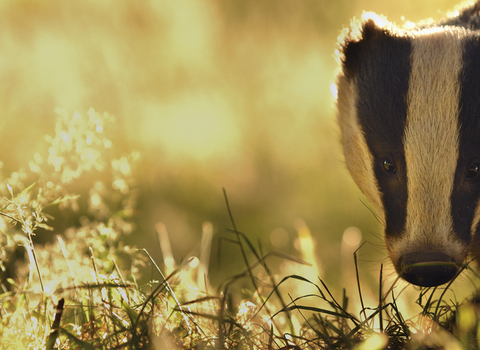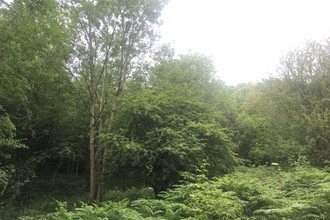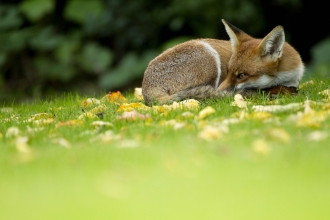Real success can only come if there is a change in our societies and in our economics and in our politics.
Campaign with us
We've been supporting, monitoring and developing campaigns and policy for wildlife for 60 years.
Today, the political environment has changed but we are still fighting for our wildlife, wild spaces and for the rights of everyone to be able to access nature. Take a look at our most pressing campaigns and show your support.
Planning
The planning system shapes the places where we live and work, and plays a vital role in determining the type and quality of landscape for future generations. Local authorities make decisions about development on the basis of planning policy. This means that all decisions on planning applications in an area are informed by the policies and supporting information set out in the Local Plan for that area.
Why is Planning Important?
Inappropriate development can significantly impact wildlife. Conversely, good planning can help protect nature and secure wildlife’s recovery through the restoration and creation of well-connected wild places. When done well, planning can improve the health and wellbeing of the community, connecting people to nature by improving and creating green and wild spaces for people and wildlife to enjoy.
Every voice counts when it comes to making a difference for our wildlife and wild places. Currently, poorly planned housing and developments dominate our country, impact wildlife and local communities – but it doesn’t have to be like that! You can help make a wilder future for your community and wildlife by getting involved in the planning system.
Derbyshire Wildlife Trust has a small planning team that comments on well over a thousand planning applications a year. You can find out more about our advisory services here. However, we don’t have unlimited resources and we think democracy works better when communities participate in local decision making.
How can You get Involved?
- Local Plans:
These set the framework for how an area will develop in future, usually over the next 15 years. Plans are revised every five years which includes a public consultation period, check when yours is next up for review! If a proposed project conforms to the plan, there’s a legal presumption councils will allow it. If it doesn’t, they have grounds to refuse. In practice, much depends on the interpretation of planning policies, the specifics of a development proposal and wider circumstances, which is why it matters that planning policies address the key issues, are well written, and supported by evidence. Find out more about Local Plans and how to comment on them here.
- Neighbourhood Plans:
Neighbourhood Plans were introduced in 2011 to enable local people to make decisions about how development proceeds in their local area. They are expected to operate at a parish or town council level and must be in line with the Local Plan. They can’t be used to block development but can be used to protect existing features of conservation value and create new green spaces for people and wildlife. Statutory authorities should ‘have regard’ to Neighbourhood Plans.
Find out if your parish or town is putting together a Neighbourhood Plan and find out how we can help you in our guide here.
- Individual Planning Applications:
Respond to planning applications you think could damage wildlife or have the potential to create more areas for wildlife or could deliver more biodiversity net gain. You can also let your local councillors and those on the planning committee know why you are objecting and encourage them to support your view. Download our guide on responding to planning applications
- Become a Team Wilder Champion:
You can become a local leader and campaign on the issues that matter to your community by becoming a Team Wilder Champion. Nothing can replicate local knowledge, drive and organisation behind community led campaigns, and if you want help to set up your own, check out our Team Wilder resources.
Where Do We Stand: Our Position At a Glance
We often get asked what we think about a range of topics, so if you want to get a better idea of our positions, we’ve summarised our thoughts into a series of short statements.
Badger Cull
Derbyshire Wildlife Trust is fully aware that bTB in cattle is a significant problem for farming in the UK and that urgent action is required to combat the disease. We particularly recognise the important role that the livestock industry can play in the environmentally sensitive management of the countryside, and the serious disruption and anxiety caused to farmers experiencing a TB herd breakdown.
However, we have always been opposed to culling badgers as we do not believe this will deliver a significant and sustained reduction in cattle TB. The role of wildlife in transmission of bovine TB (bTB) has been greatly overstated by the Government. Analysis of the Animal and Plant Health Agency’s recommendations on badger cull found serious discrepancies in the scientific method used to recommend a cull. Indeed, there is no reliable peer reviewed evidence to show that badger culling alone is having a significant impact on lowering bovine TB in cattle in or around the cull zones. Indeed, there is a very real risk of exacerbating the spread and incidence of the disease in the badger population due to the ‘perturbation effect’.
bTB is primarily a cattle disease spread by cattle. The ongoing large movements of cattle across the country continues to be one of the most significant factors in the spread of bovine TB. Measures to control the incidence and transfer of bTB should be centred on management of cattle, by reducing the risk of outbreaks occurring by way of within-farm or across-farm cattle-to-cattle transmission.
The long-term solution to controlling TB in cattle is through vaccination of cattle and we want the Government to pursue development and rollout of a TB vaccine for cattle as a matter of urgency. The solution to controlling cattle to cattle and cattle to badger transmission in the short-term is through effective testing, movement controls, and other bio-security measures (e.g. feed stores and areas where cattle are fed should be badger proofed)
We believe that vaccination of badgers is the strategy of choice to control and eventually eliminate TB in badgers. Since 2011, Derbyshire Wildlife Trust has run the largest badger vaccination programme in England. We want the Government to fund the development of an oral TB vaccine for badgers as a matter of urgency and we want to discuss how we can help to trial and deploy such a vaccine.
Find out more about the badger cull and our vaccination project here.
Access to Nature
The natural world is the foundation of our wellbeing and prosperity but also has a key role to play in tackling mental ill health. A recent Defra evidence review found that spending time in the natural environment improves our mental health and feelings of wellbeing, reducing stress, fatigue, and anxiety, as well as combatting loneliness and binding communities together.
Strikingly those living in the most deprived areas of the country are ten times less likely to live in the greenest areas. Lack of access to nature is a significant factor in preventable health inequalities and those who are most in need of the wellbeing benefits nature can bring are often those who find it most difficult to access. In 2009, Natural England estimated that £2.1 billion would be saved annually through averted health costs if everyone in England had equal access to green space.
Greener neighbourhoods have been shown to help prevent depression and reduce the burden on the NHS, but the natural world is in decline, making it harder for people to gain the benefits it provides, whilst lack of access to green space is worsening existing health inequalities. Nature can have a transformational impact on mental wellbeing but unfortunately the natural environment is in poor health itself. The most recent 'State of Nature’ Report showed that almost half of UK wildlife is in long term decline and 15% of species are at risk of extinction. If action isn’t taken to help the natural world thrive again, nature will not be there to help us improve our own wellbeing.
Connectedness to nature is the strength of a person’s relationship with nature. The University of Derby has demonstrated that there are five effective pathways to nature connectedness: tuning in to nature through the senses, experiencing the emotions that nature brings, noticing nature’s beauty, nature bringing meaning to our lives, and showing compassion for nature. Thanks to the Wildlife Trusts’ ‘30 Days Wild’ initiative, we know that taking part in actions linked to the five pathways, on consecutive days over a sustained period, increases the likelihood of a deep and meaningful connection with nature. This connection benefits people and the environment as studies show that a strong feeling of nature connectedness generates pro-environmental behaviours in individuals.
With a mission to manage a third of Derbyshire for wildlife, we are rallying a movement of local people to help deliver actions for nature in their own back yards, streets and community spaces. It is essential that Derbyshire Wildlife Trust strives to help people take positive actions for nature that are relevant, achievable and effective, and provides everyone regular and local access to nature.
We want to see everyone having access to high quality natural places near to where they live, grow, work, play and age. Research carried out by University of Essex and Leeds Beckett University into The Wildlife Trusts’ volunteering programmes showed that participating in nature conservation also has a positive impact on those with low levels of mental wellbeing. Over 12 weeks of group-based nature conservation, 95% of participants with low levels of mental wellbeing reported an improvement in their mental health within six weeks. What’s more, it also provides excellent value for money – the research showed that for every £1 invested in Wildlife Trusts’ nature volunteering programmes, there is an £8.50 social return.
Local authorities can help to improve access to nature by following the Natural England ‘Nature Nearby’ guidance. Particular regard should be given to areas with high levels of physical and/or mental health problems, and places where the amount and quality of accessible natural greenspace is below Natural England’s targets.
Rewilding
DWT Definition:
"Rewilding is the restoration of ecosystems to a point where nature can take care of itself. It seeks to reinstate natural processes and - where appropriate - missing species - allowing them to shape the landscape and habitats within.”
It is about looking forwards, not backwards. It is focused on natural systems and not individual species and we recognise this approach is breaking new ground we do not have any fixed views on the outcomes. The nature reserves we have saved are vital refuges for wildlife but they alone are not enough, wildlife needs more space to recover, move and adapt to the twin climate and ecological crises. Rewilding provides a mechanism to address the nature and climate emergency through the restoration of natural processes and by contributing to a Nature Recovery Network.
Rewilding will be a key approach as DWT seeks to connect more people to nature and engage and enthuse more people to take action to protect and restore the natural world. Rewilding is not business as usual, it is a step change strategy to assist in nature’s recovery. Rewilding covers a range of scales - even a window box could be wilder - gardens, parks, farmland, through to landscape scales.
DWT Approach:
DWT needs to practice what it preaches. We rewild on our own nature reserves by instigating natural processes where we can, whilst acknowledging that some areas will not be suitable.
Our approach to rewilding opportunities will be based on the Lawton principles of "Bigger, better, more and joined up". A rewilding approach will help us achieve our target of 30% of Derbyshire managed for wildlife by 2030, which also supports our Living Landscape approach. We need long-term, landscape-level restoration to tackle the crisis of climate change and biodiversity loss.
We actively engage with our reserve neighbours working at a landscape scale to adopt rewilding/natural solutions approaches across larger joined up areas involving our nature reserves. To be effective, we may need to replace the missing elements of broken ecosystems so that they can begin to function properly. This could be via introducing disturbance (e.g. herbivores to graze) or through the introduction of keystone species (e.g. beavers) that can alter and amend their environment to the benefit of wildlife more generally. We introduce lost species to our Living Landscapes where we can, either by facilitating their re-establishment or by direct reintroductions. We prioritise reintroductions using the following framework:
- Rapidly declining or recently extinct species (e.g. lesser spotted woodpecker, water vole, swift)
- Keystone species, which create better conditions for a range of other species (e.g. beaver, sphagnum, meadow ant, large herbivores);
- Umbrella species, which need conditions which are also required by other species (e.g. pine marten, salmon, black grouse, Eurasian crane, red-backed shrike);
- Citizen zoo species, where we can work with communities on reintroductions and reinforcements (e.g. many invertebrates, eels, harvest mice);
- Charismatic species which capture the public imagination.
Find out more about rewilding and Derbyshire Wildlife Trust’s flagship Wild Peak project.
Natural Flood Management
The Wildlife Trusts believe that the impact of floods and storm events in the UK can be reduced if action is taken to protect and restore floodplains and coastal wetlands. Natural floodplains, which incorporate wetlands, permanent grassland or woodland soak up water and release it more slowly than other land uses, such as arable farmland, housing or industrial developments. The Government and its agencies should recognise these vital functions provided by flood plains and coastal wetlands and actively promote their protection and restoration because:
- Storms and floods are likely to become more frequent as a result of climate change. Their effects will be exacerbated by sea level rise. The reduction of risk to people and property from these extreme weather events is paramount and it is important that we manage our coast and river basins accordingly.
- Experience in recent years has shown that hard engineering is not always the best means of reducing risks. In many places, maintenance and restoration of floodplain and coastal wetlands is more effective. By working with nature, rather than against it, we can better protect people and property as well as providing valuable natural habitats for wildlife.
- The escalating cost of maintaining flood and coastal defences is putting authorities under pressure. Sustainable options for flood management, which take account of socioeconomic constraints as well as environmental objectives, are urgently needed
The Wildlife Trusts recommend that funding for flood management and coastal defence should focus on the following priorities for action:
- Planning guidance should protect floodplains from development: Government should put in place policies that strongly discourage further inappropriate development on floodplains. Environment Agencies should be given the power to block specific development proposals that put floodplains at risk, or that reduce their natural flood storage or water absorption capacity. Change of use of existing buildings also needs controlling. One reason why damage is so great is that a lot of old buildings in flood risk areas have been converted to uses that are inappropriate.
- All new developments should incorporate Sustainable Drainage Systems (SuDS): All new developments should incorporate Sustainable Drainage Systems (SuDS). These systems control the generation of run-off at source by using more permeable materials in the construction of roads, pavements and car parks. By encouraging infiltration of rainwater into the ground, and by retaining run-off in ponds, SuDS increase the storage capacity of river basins, improve water quality and provide valuable wetland habitat, and therefore reduce the likelihood and severity of floods. SuDS achieve this often at a fraction of the cost of conventional systems.
- Wetland restoration should be given priority as a means of flood management in river basins: Flood management schemes should work with nature rather than against it, as many schemes based on hard engineering cannot cope with the flow levels that will become more common in the future. Worse still, such schemes often exacerbate flooding problems in downstream areas. The Government should give greater priority to restoration of natural wetland habitats as a means of flood management.
- Farmers and landowners have a key role to play in flood management: Support should be provided for farmers and landowners who manage their land in ways that help to reduce flooding. Changing arable farming practices, restoring wetlands, increasing native tree cover and maintaining landscape features such as hedgerows and ponds can all help to reduce run-off, increase the storage capacity of river basins and reduce peak river flows.
Find out more about NFM and our work to #slowtheflow - Derwent Connections.
Use of Pesticides
The abundance of insects has declined by as much as 50% since 1970, with the use of pesticides and other pollutants as one of the key drivers for decline. The catastrophic decline in insects is caused primarily by the routine and widespread use of pesticides. Significant reduction in pesticide use is required to reverse insect declines, improve human health, and create a wilder future. Failure to reduce pesticide use risks a collapse of the natural systems on which humans and wildlife rely on for health and food supply. This requires leadership from the Government to create effective legislation, regulation and enforcement around pesticide use, ambitious pesticide reduction targets, and provide support for farmers and land managers to switch to alternatives. Alongside government, everyone can play their part by reducing domestic and unnecessary use of pesticides.
Many pesticides are freely available to be used by untrained members of the public which can further lead to pesticides becoming present in higher doses or within inappropriate environments (such as waterways), increasing their negative impact on both target and non-target organisms.
We accept that total eradication of pesticide use may not be possible for all farmers and in some circumstances is necessary to safeguard the health of livestock. However, it is possible to greatly reduce pesticide use while maintaining comparable crop yields and vegetation control - if sufficient effort is made to develop ecologically based Integrated Pest Management (IPM) methods and to adopt non-chemical solutions. These techniques can also reduce the costs of any chemical application and can therefore often be more profitable than traditional management.
We believe Government led action is needed to underpin a shift to chemical-free alternatives. Public bodies, businesses and communities need confidence, education and incentives to drive the uptake of chemical-free alternatives to pesticides. The Government and Derbyshire City Council should encourage and practically support:
- farmers to adopt Integrated Pest Management and other agroecological practices through independent technical advice and incentives;
- Local Authorities to become Pesticide Free Towns
- all landowners to reduce the use of pesticides on their land.






